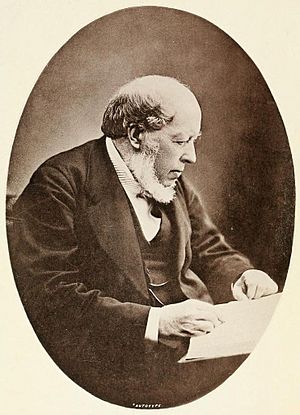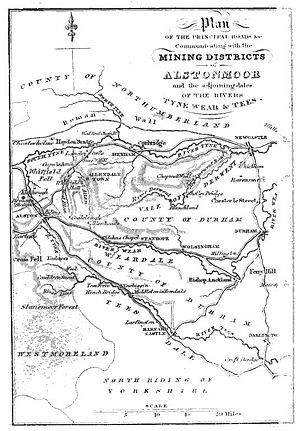Thomas Sopwith (geologist) facts for kids
Thomas Sopwith (born January 3, 1803 – died January 16, 1879) was a clever English mining engineer. He also taught about geology (the study of Earth's rocks and history). Plus, he was a local historian, meaning he studied the past of his area. He was even a Fellow of the Royal Society, which is a big honor for scientists.
Contents
Early Life and Cool Inventions
Thomas Sopwith was born in Newcastle-upon-Tyne. His dad, Jacob Sopwith, was a builder and made furniture. Thomas stayed connected to the family business his whole life.
At first, Thomas drew old buildings and artifacts. Then, he started surveying land and minerals. This means he measured land and found where valuable rocks or metals were. He later called himself a civil engineer.
He invented some neat things! One was a special desk called the 'monocleid'. All its drawers could be locked with just one key. This desk even won an award at the famous Great Exhibition in 1851. He also made a better tool for measuring levels and wooden models to help teach geology.
His Amazing Career
Mining Engineer Work
In 1824, Thomas finished learning his trade from his father. He then started working as a surveyor. He worked closely with Richard Grainger to help rebuild parts of Newcastle Upon Tyne.
He also surveyed lead mines in an area called Alston, Cumbria. Later, he made many friends in London, especially in the world of geology. He became a member of the Geological Society of London in 1835.
Sopwith believed it was important to collect and keep records of mine surveys. He worked on a survey in Northumbria with William Smith, a famous geologist. Thanks to Sopwith, the government started the Mining Record Office in 1838. This office kept important information about mines. In the same year, he surveyed mines in County Clare, Ireland.
From 1845 until he retired in 1871, Sopwith worked in Allenheads, Northumberland. He was an agent for a big lead mining company there.
Building Railways
Thomas Sopwith also became a railway surveyor. He worked on many projects, including a plan for a central railway station in Newcastle with Richard Grainger.
He even worked with famous railway pioneers like George Stephenson and Sir William Cubitt. They helped create the railway network in France.
In 1843, he helped develop railways in Belgium. He did the first surveys for the Sambre-Meuse line. He even went on an inspection trip with George Stephenson. Sopwith also thought it was important to record the geological features found when digging railway cuttings. Because of his idea, the British Association gave money in 1840 to do this.
Teaching with Models
Sopwith was one of the first people to use 3D models. He used them to show how geology looked in real places like the Forest of Dean. He also made sets of these models for teaching. Different colored woods showed different types of rock. This made learning about geology much easier and more fun!
His Family Life
Thomas Sopwith was married three times. First, to Mary Dickenson in 1828, who passed away in 1829. Then, to Jane Scott in 1831, who passed away in 1855. Finally, to Anne Potter in 1858.
He had eight children. One of his grandsons, also named Thomas Sopwith, became very famous. He founded the Sopwith Aviation Company, which built many airplanes, including some used in wars.
Thomas Sopwith passed away in London. He was buried at West Norwood Cemetery, where there's even a path named "Sopwith Path."
Awards and Special Recognitions
Thomas Sopwith was a member of many important groups and societies. These included the Royal Society, the Institution of Civil Engineers, and the Royal Geographical Society.
In 1842, he won the Telford Silver Medal from the Institute of Civil Engineers. He was also chosen as the fifth President of the Royal Meteorological Society in 1859.
In 1845, he became a Fellow of the Royal Society. This honor recognized him for his book on isometric drawing and for inventing ways to show mineral structures using models.
His Writings and Diaries
In 1826, Sopwith published a book about All Saints' Church in Newcastle. He also wrote a book about the mining area of Alston, Cumbria. He wrote two books about using isometric projection for drawing surveys. He also wrote about why it was important to keep mining records.
His Detailed Diaries
Thomas Sopwith kept detailed diaries for 57 years, from 1821 to 1878! He wrote about his daily life, both at work and at home. He traveled a lot, first by coach and then by train. He wrote down travel times, prices, and conditions in his diaries.
His diaries also tell us about the famous people he met. These included Charles Babbage, who designed early computers, Charles Darwin, who developed the theory of evolution, and John Ruskin, a famous writer and artist. His diaries are now kept at Newcastle University Library. People at the time also thought Sopwith was a great artist, especially good at drawing cartoons.
Other Books He Wrote
- Eight Views of Fountains Abbey (1832)
- Description of Monocleid Writing Cabinets (1841?)
- An Account of the Museum of Economic Geology (1843)
- Education: its Present State and Future Advancement (1853)
- Notes of a Visit to Egypt (1857)
- Notes of a Visit to France and Spain (1865)
- Education in Village Schools (1868)
- Three Weeks in Central Europe (1869)




